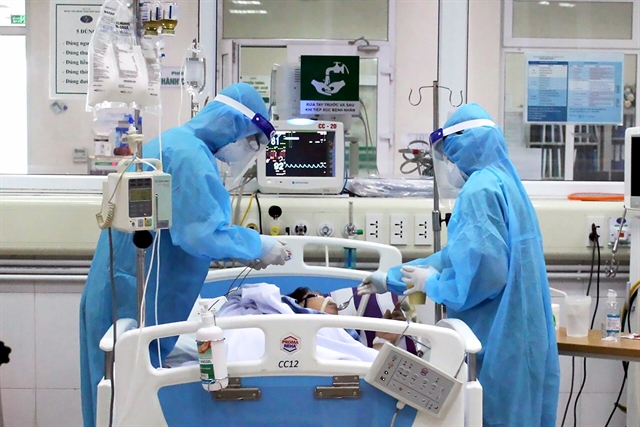 Society
Society

The number of patients infected with COVID-19, who have to go to hospital for treatment, has been on the rise recently in Hà Nội.

|
| Doctors treating a COVID-19 patient at the National Hospital for Tropical Diseases in Hà Nội. — VNA/VNS Photo Hồng Hà |
HÀ NỘI — The number of patients hospitalised with COVID-19 has been on the rise recently in Hà Nội.
Most patients have underlying medical conditions and none of them has received the booster doses of the COVID-19 vaccine.
The National Hospital for Tropical Diseases is currently treating 61 COVID-19 patients, including 18 severe patients.
Of the 18 severe patients, two require oxygen through a mask and 15 need further oxygen aid.
Trần Văn Giang, deputy head of the hospital’s Department of Virus and Parasitology, talked to Nhân Dân (The People) online newspaper. Giang said that in April and May, the department received an average of one or two COVID-19 patients per day.
However, since mid-June, the department has been receiving about seven to 10 COVID-19 patients per day, he said.
The number of COVID-19 patients is on the rise and the department’s beds are almost full, he said.
Among the patients, up to one-third of cases are severe, he added.
Data from the hospital shows that the hospital’s Intensive Care Unit (ICU) Department currently has 20 recovery beds for COVID-19 patients, and 17 are taken with severe cases.
The number of critically-ill patients admitted to the ICU department has doubled compared to the previous month.
There has also been a slight increase in COVID-19 cases hospitalised at the COVID-19 Treatment Hospital in Hoàng Mai District.
Every day in the past three weeks, the hospital has been receiving between one and three cases a day.
During May and April, the hospital would go days with no new COVID admissions.
Associate Professor Hoàng Bùi Hải, deputy director, said that the hospital is currently treating about 20 COVID-19 patients, including two cases that require oxygen; the rest are mild patients.
The patients mainly have underlying diseases, he said.
The same situation also happened at Thanh Nhàn Hospital.
The hospital said that on July 5, they received 20 COVID-19 patients. In the previous weeks, there were only four or five cases of COVID019 being hospitalised each week.
Nguyễn Thị Thu Hương, head of the Anti-Pandemic Unit and head of the Department of Occupational Diseases, said COVID-19 patients, who have been hospitalised, mainly have underlying medical conditions.
Data from these hospitals reveal that no patient has received the second booster dose of COVID-19.
Meanwhile, the sub-variant of Omicron named BA. 5 has entered Việt Nam with a very strong infectious ability, requiring people to have a second booster shot to get active immunity.
Hương said that patients with COVID-19, who received the second booster dose, will not suffer from severe complications.
Vaccine is the most effective tool
Epidemiologists said the number of severe cases and deaths has decreased sharply thanks to the decrease in new cases as well as high vaccine coverage.
However, the vaccine immunity is reduced after six months, therefore, people with underlying diseases and the elderly, who do not receive the booster doses of the vaccine, might suffer more severe complications if they infect with COVID-19, epidemiologists said.
If the number of COVID-19 cases increases, the risk of overloading the health system, the severe cases and deaths will increase, epidemiologists said.
In response to the situation, the Ministry of Health has ordered localities to speed up vaccination for children aged from five to under 12 years old and administer booster doses for people 18 years and over.
Doctors recommend that people should get doses following the guidance of the health ministry, especially the elderly, who have underlying diseases, and immunocompromised people so that if they infect with COVID-19, the symptoms will be milder.
When people get the booster doses of the COVID-19 vaccine, they will strengthen their immunity and especially, prevent the sub-variant BA.5.
If infected with COVID-19, the disease will also be milder after the booster doses.
Currently, Việt Nam has one of the highest vaccination rates in the world.
The coverage of the second dose per the total population is approximately 80 per cent, 30 per cent higher than the World Health Organisation’s target.
The rate of the first booster dose for people aged 18 and over is twice the world average.
The rate of basic injection for children from 5 to under 12 years old is higher than in countries such as Italy, Germany, the USA, Denmark and Poland. — VNS